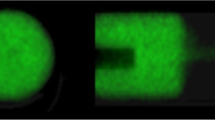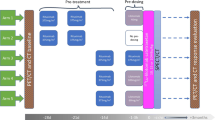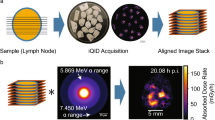Abstract
Purpose
Improved data collection methods have improved absorbed dose estimation by tracking activity distributions and tumor extent at multiple time points, allowing individualized absorbed dose estimation. Treatment with tositumomab and 131I-tositumomab anti-CD20 radioimmunotherapy (BEXXAR) yields a cold antibody antitumor response (cold protein effect) and a radiation response. Biologically effective contributions, including the cold protein effect, are included in an equivalent biological effect model that was fit to patient data.
Methods
Fifty-seven tumors in 19 patients were followed using 6 single proton emission computed tomography (SPECT)/CT studies, 3 each post tracer (5 mCi) and therapy (∼100 mCi) injections with tositumomab and 131I-tositumomab. Both injections used identical antibody mass, a flood dose of 450 mg plus 35 mg of 131I tagged antibody. The SPECT/CT data were used to calculate absorbed dose rate distributions and tumor and whole-body time-activity curves, yielding a space-time dependent absorbed dose rate description for each tumor. Tumor volume outlines on CT were used to derive the time dependence of tumor size for tracer and therapy time points. A combination of an equivalent biological effect model and an inactivated cell clearance model was used to fit absorbed dose sensitivity and cold effect sensitivity parameters to tumor shrinkage data, from which equivalent therapy values were calculated.
Results
Patient responses were categorized into three groups: standard radiation sensitivity with no cold effect (7 patients), standard radiation sensitivity with cold effect (11 patients), and high radiation sensitivity with cold effect (1 patient).
Conclusion
Fit parameters can be used to categorize patient response, implying a potential predictive capability.







Similar content being viewed by others
Notes
In the earlier publication, the BED included the cold effect term. While others have used a broader definition of BED to include non-absorbed dose quantities [8, 9], the stronger the terms not associated with absorbed dose, the more awkward it is to assign total therapy effect to an absorbed dose effect quantity.
References
Dewaraja YK, Wilderman SJ, Koral KF, Kaminski MS, Avram AM. Use of integrated SPECT/CT imaging for tumor dosimetry in I-131 radioimmunotherapy: a pilot patient study. Cancer Biother Radiopharm 2009;24:417–26.
Kaminski MS, Zasadny KR, Francis IR, Milik AW, Ross CW, Moon SD, et al. Radioimmunotherapy of B-cell lymphoma with [131]anti-B1 [anti-CD20] antibody. N Engl J Med 1993;329:459–65.
Kaminski MS, Estes J, Zasadny KR, Francis IR, Ross CW, Tuck M, et al. Radioimmunotherapy with iodine (131)I tositumomab for relapsed or refractory B-cell non-Hodgkin lymphoma: updated results and long-term follow-up of the University of Michigan experience. Blood 2000;96:1259–66.
Davis TA, Kaminski MS, Leonard JP, Hsu FJ, Wilkinson M, Zelenetz A, et al. The radioisotope contributes significantly to the activity of radioimmunotherapy. Clin Cancer Res 2004;10:7792–8.
Fowler JF. The linear-quadratic formula and progress in fractionated radiotherapy. Br J Radiol 1989;62:679–94.
Wheldon TE, O’Donoghue JA. The radiobiology of targeted radiotherapy. Int J Radiat Biol 1990;58:1–21.
Fowler JF. Radiobiological aspects of low dose rates in radioimmunotherapy. Int J Radiat Oncol Biol Phys 1990;18:1261–9.
Fowler JF. Correction to Kasibhatla et al. How much radiation is the chemotherapy worth in advanced head and neck cancer? (Int J Radiat Oncol Biol Phys 2007;68:1491–1495). Int J Radiat Oncol Biol Phys 2008;71:326–9.
Plataniotis GA, Dale RG. Use of the concept of equivalent biologically effective dose (BED) to quantify the contribution of hyperthermia to local tumor control in radiohyperthermia cervical cancer trials, and comparison with radiochemotherapy results. Int J Radiat Oncol Biol Phys 2009;73:1538–44.
Prideaux AR, Song H, Hobbs RF, He B, Frey EC, Ladenson PW, et al. Three-dimensional radiobiologic dosimetry: application of radiobiologic modeling to patient-specific 3-dimensional imaging-based internal dosimetry. J Nucl Med 2007;48:1008–16.
O’Donoghue JA. Implications of nonuniform tumor doses for radioimmunotherapy. J Nucl Med 1999;40:1337–41.
Amro H, Wilderman SJ, Dewaraja YK, Roberson PL. Methodology to incorporate biologically effective dose and equivalent uniform dose in patient-specific 3-dimensional dosimetry for non-Hodgkin lymphoma patients targeted with 131I-tositumomab therapy. J Nucl Med 2010;51:654–9.
Dewaraja YK, Schipper MJ, Roberson PL, Wilderman SJ, Amro H, Regan DD, et al. 131I-Tositumomab radioimmunotherapy: initial tumor dose-response results using 3-dimensional dosimetry including radiobiologic modeling. J Nucl Med 2010;51:1155–62.
Kaminski MS, Zasadny KR, Francis IR, Fenner MC, Ross CW, Milik AW, et al. Iodine-131-anti-B1 radioimmunotherapy for B-cell lymphoma. J Clin Oncol 1996;14:1974–81.
Wilderman SJ, Dewaraja YK. Method for fast CT/SPECT-based 3D Monte Carlo absorbed dose computations in internal emitter therapy. IEEE Trans Nucl Sci 2007;54:146–51.
Pinheiro JC, Bates DM. Approximations to the log-likelihood function in the nonlinear mixed-effects model. J Comput Graph Stat 1995;4:12–35.
Dale RG. The application of the linear-quadratic dose-effect equation to fractionated and protracted radiotherapy. Br J Radiol 1985;58:515–28.
Macklis RM, Beresford BA, Humm JL. Radiobiologic studies of low-dose-rate 90Y-lymphoma therapy. Cancer 1994;73(3 Suppl):966–73.
Hernandez MC, Knox SJ. Radiobiology of radioimmunotherapy: targeting CD20 B-cell antigen in non-Hodgkin’s lymphoma. Int J Radiat Oncol Biol Phys 2004;59:1274–87.
Marples B, Lambin P, Skov KA, Joiner MC. Low dose hyper-radiosensitivity and increased radioresistance in mammalian cells. Int J Radiat Biol 1997;71:721–35.
Koster A, Tromp HA, Raemaekers JM, Borm GF, Hebeda K, Mackenzie MA, et al. The prognostic significance of the intra-follicular tumor cell proliferative rate in follicular lymphoma. Haematologica 2007;92:184–90.
Tang B, Malysz J, Douglas-Nikitin V, Zekman R, Wong RH, Jaiyesimi I, et al. Correlating metabolic activity with cellular proliferation in follicular lymphomas. Mol Imaging Biol 2009;11:296–302.
Acknowledgments
This work was supported by grant 2R01 EB001994 awarded by the National Institute of Health, US Department of Health and Human Services. The authors thank Ken Koral, Ph.D. for many useful discussions.
Author information
Authors and Affiliations
Corresponding author
Electronic supplementary material
Below is the link to the electronic supplementary material.
Rights and permissions
About this article
Cite this article
Roberson, P.L., Amro, H., Wilderman, S.J. et al. Bio-effect model applied to 131I radioimmunotherapy of refractory non-Hodgkin’s lymphoma. Eur J Nucl Med Mol Imaging 38, 874–883 (2011). https://doi.org/10.1007/s00259-010-1699-3
Received:
Accepted:
Published:
Issue Date:
DOI: https://doi.org/10.1007/s00259-010-1699-3




